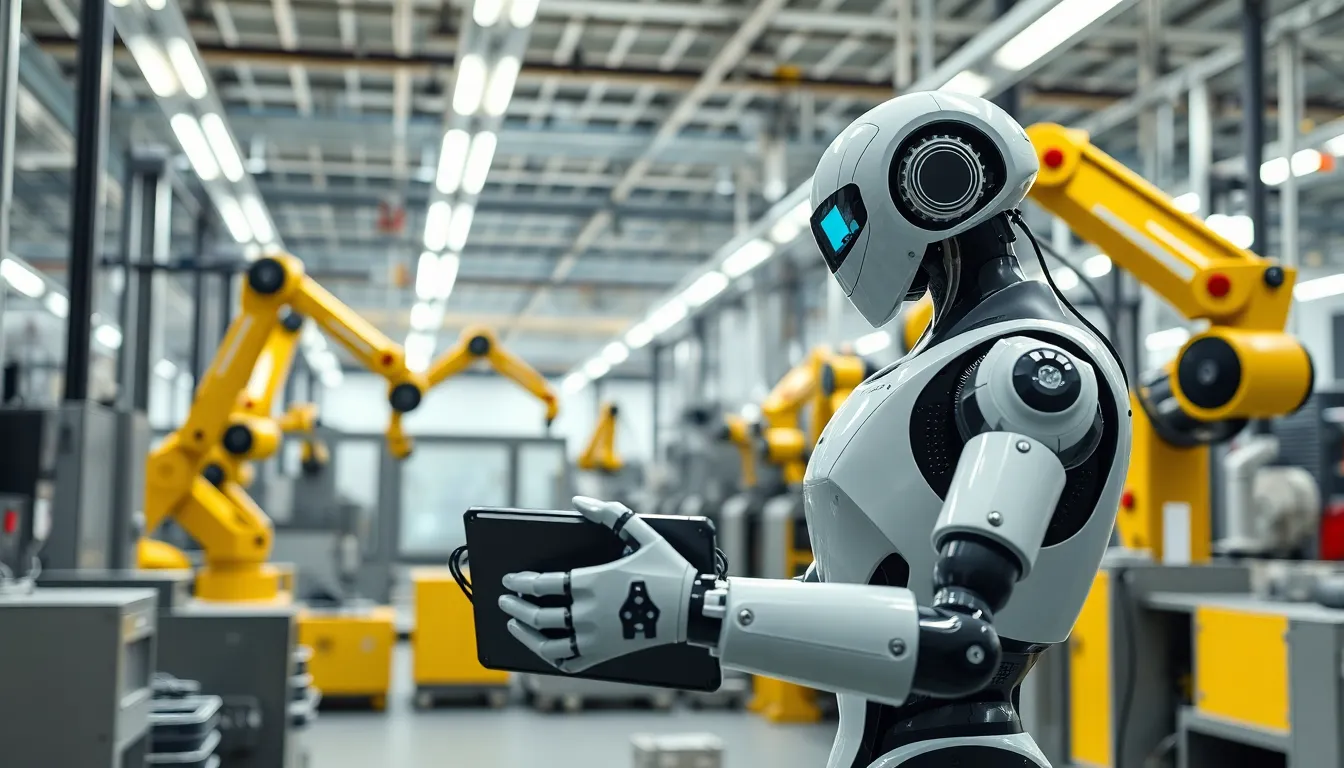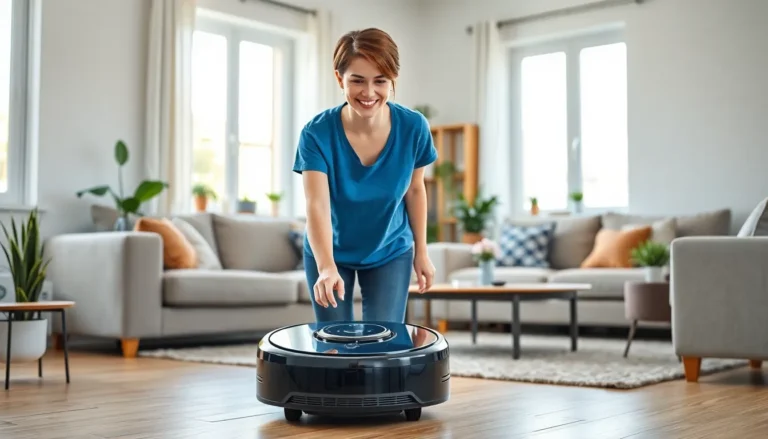In a world where robots are no longer just the stuff of sci-fi movies, autonomous robotics is stepping into the spotlight. Imagine a future where machines handle mundane tasks while you kick back with a cup of coffee—sounds dreamy, right? These high-tech marvels are not just about flashy gadgets; they’re revolutionizing industries from manufacturing to healthcare, making life easier and maybe a bit more entertaining.
But don’t let the sleek designs fool you. Autonomous robots are like that overachieving friend who always brings snacks to the party—they just keep giving. With advancements in artificial intelligence and machine learning, these robots are becoming smarter and more efficient, ready to tackle challenges humans might find daunting. So buckle up as we dive into the fascinating world of autonomous robotics, where innovation meets a sprinkle of humor and a whole lot of potential.
Table of Contents
ToggleOverview of Autonomous Robotics
Autonomous robotics represents a significant evolution in technology. This field encompasses robots capable of performing tasks without human intervention, driven by advanced algorithms and sensory systems.
Definition and Scope
Autonomous robots operate independently by utilizing artificial intelligence and machine learning technologies. These systems make decisions based on environmental data, allowing robots to adapt to various conditions. The scope of autonomous robotics extends across numerous sectors, including industrial automation, healthcare, transportation, and service industries. For example, robots in manufacturing streamline production processes, while drones assist in agriculture by monitoring crops. This technology reshapes how tasks are accomplished, enhancing efficiency and accuracy.
Types of Autonomous Robots
Different types of autonomous robots cater to a variety of applications. Industrial robots excel in performing heavy-duty tasks such as welding and assembly. Service robots, designed for hospitality and customer service, interact directly with people to facilitate tasks like cleaning and delivery. Autonomous vehicles navigate roads and transport passengers without human input, exemplifying advancements in transportation. Drones, another prevalent form, conduct aerial surveillance and deliver goods. Each type demonstrates unique capabilities that highlight the versatility of autonomous robotics in modern society.
Applications of Autonomous Robotics

Autonomous robotics plays a crucial role in various industries, significantly improving efficiency and performance across different sectors.
In Manufacturing
Manufacturing facilities utilize autonomous robotics for precision and efficiency. Robots assemble products, reducing human error and increasing production speed. Advanced systems perform quality inspections in real-time, ensuring consistency. Companies experience lower operational costs as robots take over repetitive tasks. Increased safety also occurs since robots handle hazardous materials and work in extreme environments.
In Healthcare
Healthcare systems integrate autonomous robotics to enhance patient care and streamline operations. Surgical robots assist surgeons during complex procedures, improving accuracy and minimizing recovery times. Delivery robots transport medications and supplies, saving time and reducing the burden on medical staff. Patients benefit from telepresence robots, allowing remote consultations with physicians. With the ability to monitor vital signs, robots enhance patient safety and data collection.
In Exploration
Exploration processes rely on autonomous robotics for data collection in inaccessible environments. Underwater drones survey ocean floors, conducting research on marine biology. Space rovers explore planetary surfaces, gathering valuable information for future missions. Autonomous aerial vehicles perform aerial photography, mapping terrains and monitoring wildlife. These robots facilitate missions, pushing the boundaries of what can be discovered.
Technologies Behind Autonomous Robotics
Autonomous robotics relies on various advanced technologies that enable machines to operate independently. The integration of these technologies pushes the boundaries of robotic capabilities across numerous industries.
Artificial Intelligence
Artificial intelligence serves as the brain of autonomous robots, allowing for decision-making and learning. Machine learning algorithms analyze data patterns, enhancing the robot’s ability to adapt to new environments. Natural language processing enables communication with humans, facilitating seamless interaction. AI-driven perception systems help robots understand their surroundings, interpreting sensory input accurately. These capabilities increase efficiency and effectiveness, making robots ideal for complex tasks.
Sensor Technologies
Sensor technologies play a critical role in enhancing autonomous robotics functionality. Vision sensors, such as cameras, capture visual information, allowing robots to navigate and recognize objects. Proximity sensors detect obstacles, ensuring safe movement in dynamic environments. Additionally, tactile sensors provide feedback on touch, enabling robots to interact with objects delicately. GPS and inertial measurement units further assist in precise positioning and navigation. Together, these sensor technologies create a comprehensive awareness of surroundings.
Control Systems
Control systems dictate how autonomous robots execute tasks and manage movements. These systems rely on algorithms to process input from sensors, enabling real-time decision-making. Feedback loops adjust actions based on environmental changes, enhancing responsiveness and reliability. Advanced control methods, such as model predictive control, improve performance in uncertain conditions. Robust control architecture ensures stability in various scenarios, making robots more dependable for diverse applications. Effective control systems develop the foundation for precision and control in autonomous operations.
Challenges in Autonomous Robotics
Autonomous robotics faces various challenges that impact their development and deployment across industries. These challenges include technical limitations, ethical considerations, and regulatory issues that shape the landscape of autonomous solutions.
Technical Limitations
Technical limitations hinder the effectiveness of autonomous robots. Sensors may struggle to accurately perceive complex environments, leading to navigation difficulties. Algorithms can face constraints in processing speed and complexity, which limits real-time decision-making capabilities. Furthermore, battery life and power management remain critical issues, affecting the operational duration of robots. Solutions must address these limitations to improve reliability and enhance performance in diverse applications.
Ethical Considerations
Ethical considerations play a significant role in the advancement of autonomous robotics. The potential for job displacement raises concerns about the workforce in various sectors. Decision-making algorithms may inadvertently reflect biases, leading to unequal outcomes in critical situations. Privacy issues also arise with data collection and surveillance capabilities of autonomous robots. Addressing these ethical dilemmas is essential for gaining public trust and ensuring responsible implementation of robotic technologies.
Regulatory Issues
Regulatory issues present significant obstacles for the deployment of autonomous robots. Governments and organizations must establish guidelines to govern safety and liability in robotics applications. Current regulations often lag behind technological advancements, creating uncertainty for developers and businesses. Clear frameworks are necessary to facilitate the integration of autonomous robots into society while protecting public interests. Developing comprehensive regulations will support the responsible growth of this evolving industry.
Future of Autonomous Robotics
Autonomous robotics is set to significantly change various sectors in the coming years. Continued advancements promise exciting innovations and impactful societal changes.
Innovations on the Horizon
Forecasts predict breakthroughs in sensory integration, allowing robots to navigate complex environments more effectively. Enhanced AI algorithms will improve decision-making, leading to smarter robots capable of adapting to dynamic situations. Swarm robotics could emerge, where multiple robots collaborate to accomplish tasks collectively. Improved human-robot interaction strategies may lead to more intuitive communication between people and robots. Developments in energy efficiency could enable longer operation times, making robots more practical for various applications.
Impact on Society
Autonomous robotics is likely to reshape job markets by automating repetitive tasks, freeing people for more creative roles. Healthcare will benefit from robots assisting in surgeries, offering precision beyond human capabilities. In transportation, autonomous vehicles could reduce traffic accidents and improve efficiency on roads, making travel safer. Enhanced productivity in manufacturing might translate to lower costs for consumers, driving economic growth. Furthermore, autonomous drones will play vital roles in monitoring and delivering goods, changing logistics and supply chain operations significantly.
The rise of autonomous robotics marks a pivotal shift in how industries operate and how individuals engage with technology. As these robots become integral to various sectors their ability to enhance efficiency and safety stands out. The ongoing advancements in AI and machine learning promise to further elevate their capabilities making them smarter and more adaptable.
While challenges remain the potential for autonomous robotics to redefine work and daily life is immense. With careful consideration of ethical implications and regulatory frameworks society can harness these innovations for a brighter future. The journey of autonomous robotics is just beginning and its impact will undoubtedly shape the landscape of tomorrow.




